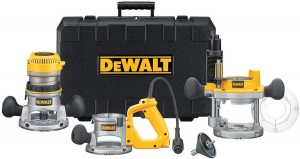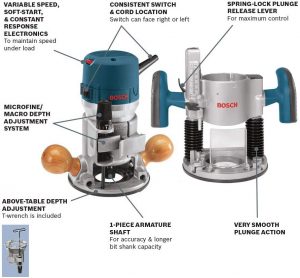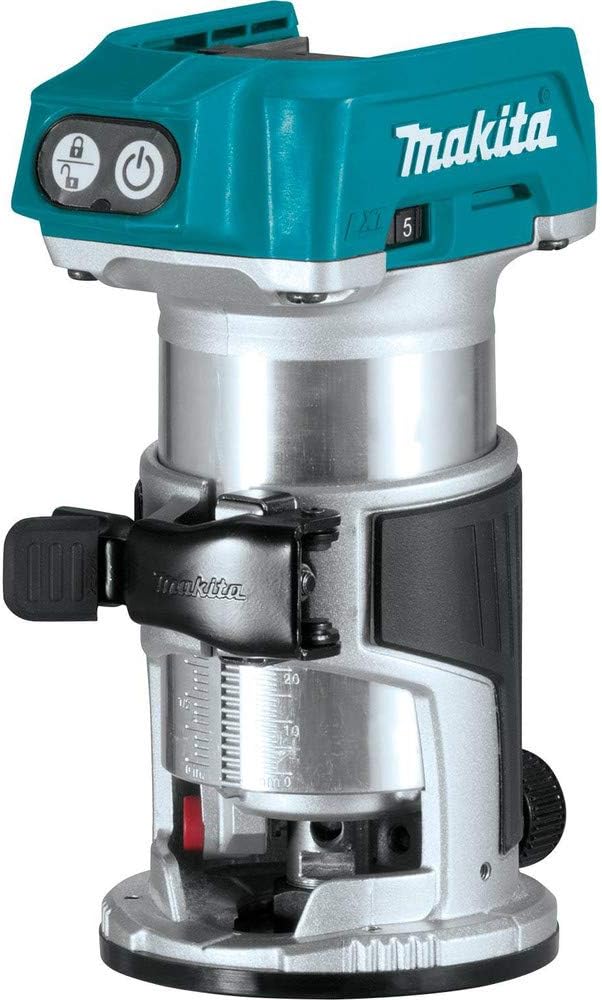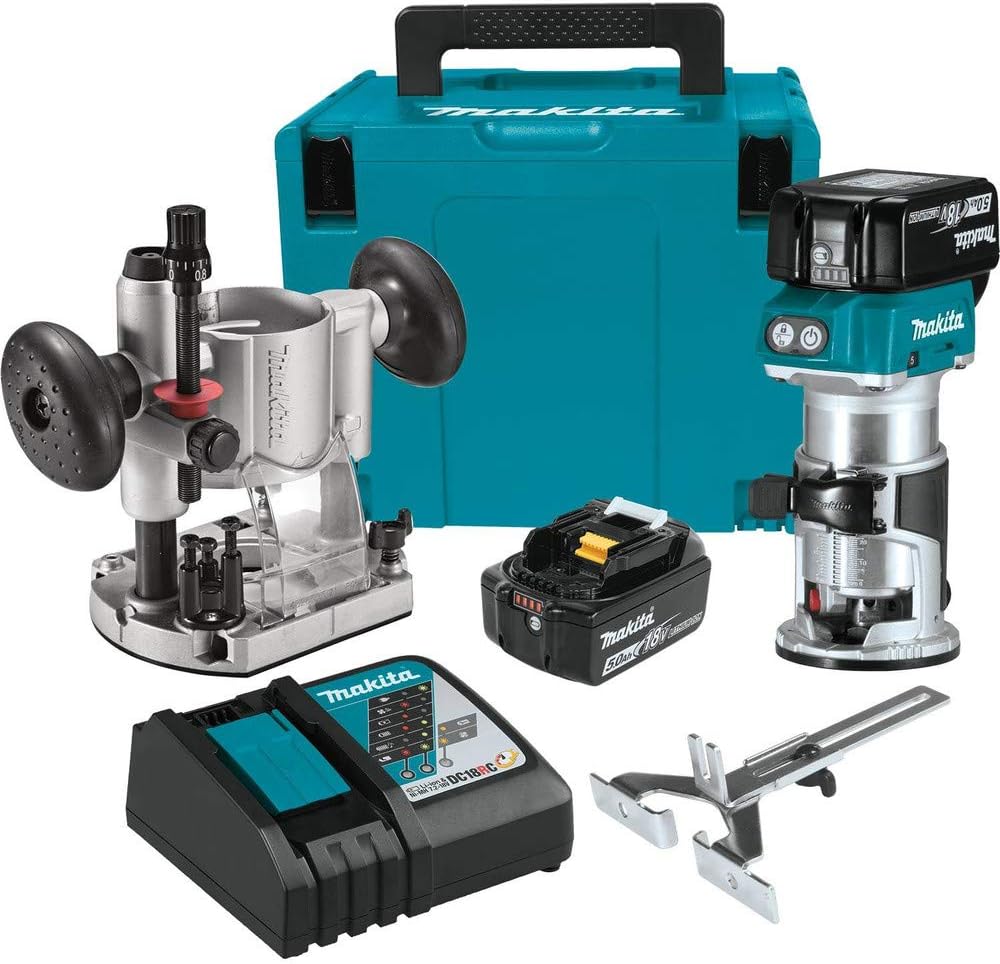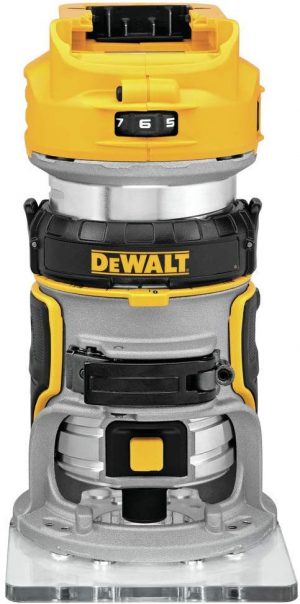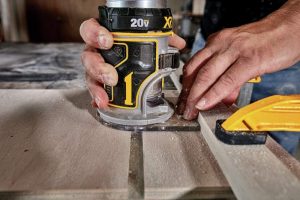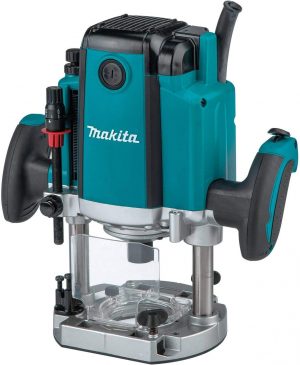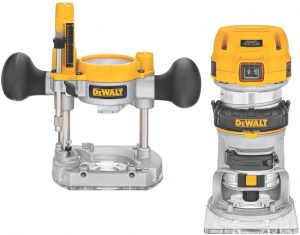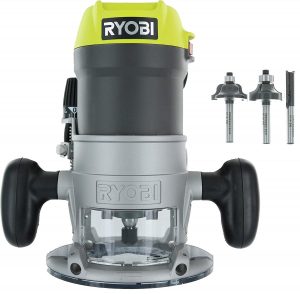Wood Routers Worth Knowing About in 2026

Wood routers spin cutting bits at serious speeds to shape, profile, and cut wood in ways that would take forever by hand. The cutting bit locks into a collet connected to the motor shaft, and depending on whether you've got a fixed base or plunge router, that bit either stays at a set depth or plunges down into the material as you work.
These tools show up in cabinet shops for cutting precise joinery, in restoration work where traditional joints matter, and on job sites where edge profiles and hinge mortises need to happen fast. Router jigs create repeatable cuts by giving the bit a template to follow, which becomes relevant when you're making multiples of anything.
The router handles tasks like rebates, dados, mortises, fluting, inlay work, dovetails, and edge profiling. Fixed base models lock the bit at a specific depth for edge work and consistent cuts. Plunge routers let you start cuts in the middle of a workpiece, with spring-loaded supports that control how far the bit drops into the material.
What Different Router Configurations Actually Do
Variable speed control exists because different materials and bit sizes require different RPMs. Larger diameter bits generate more surface speed at the cutting edge even at lower RPM, while smaller bits can spin faster without generating excessive heat. Electronic speed control holds the RPM steady even when the bit hits denser grain or knots.
Motor power determines how the router responds to hardwoods and sustained cuts. A 12-amp motor pushing 2+ horsepower cuts through maple or oak without bogging down. Lower-powered routers handle softer woods and lighter edge work, but struggle when hogging out material or working with dense exotics.
Dust collection systems pull chips away from the cutting path so you can see what you're doing. Through-column collection captures most of the debris before it flies everywhere, though hooking up a shop vac remains necessary for serious work.
Collet size determines what bits you can use. Half-inch collets accept larger, more aggressive bits and generally indicate a more versatile machine. Quarter-inch collets work for detail work and smaller profiles. Many routers include adapters so a half-inch collet can accept quarter-inch shanks.
DeWalt DW618B3 Router Kit
DeWalt DW618B3 Fixed/Plunge Base Kit - 12.0 amp, 2.25 HP motor / Variable speed 8,000-24,000 RPM / Includes fixed base, plunge base, and D-handle base / Micro-fine depth adjustment in 1/64" increments / Through-column dust collection captures 95% of debris
This kit provides three different base configurations for the same motor pack. The fixed base handles edge work and template routing. The plunge base takes care of mortises, dados, and any cut that starts in the middle of the workpiece. The D-handle base offers a different grip style that some operators prefer for freehand work.
The soft start motor ramps up gradually instead of lurching at full power right away, which affects accuracy when starting a cut. The electronic variable speed holds RPM constant even when the bit hits harder grain. The depth adjustment ring clicks in 1/64-inch increments on the fixed base, with even finer 5/128-inch adjustment on the plunge base.
Die-cast aluminum construction keeps the bases and motor housing rigid. Precision-machined brass bushings and hardened steel guide rods make the plunge action smooth without any side-to-side wobble. The through-column dust port pulls in debris instead of just deflecting it, though some dust escapes around the bit.
Check current pricing on Amazon
Bosch 1617EVSPK Combo Kit
Bosch 1617EVSPK Wood Router Tool Combo - 12.0 amp, 2.25 HP motor / Variable speed 8,000-25,000 RPM / Weighs 18.2 lbs / Includes fixed base, plunge base, 1/4" and 1/2" collets / Dust-sealed motor housing
The hardwood handles aren't just aesthetic. At 18.2 pounds, this router has enough mass that it resists skittering around during cuts, and the real wood grip provides purchase to control it. The weight affects how the tool behaves when making deep cuts or working with figured wood where the grain changes direction.
Constant response circuitry monitors the load and adjusts power delivery to maintain the set RPM. When the bit hits a knot or denser grain, the motor compensates instead of slowing down. This shows up as cleaner cut quality and fewer burn marks from the bit dwelling too long in one spot.
The soft start feature exists because when a 2.25 HP motor hits full speed instantly, it can jerk the router enough to mess up the starting position. Gradual acceleration gives the operator a second to adjust grip and confirm the bit's tracking where intended.
The kit includes both collet sizes, wrenches for bit changes, chip shields, and a carrying case. Bosch makes a compatible benchtop router table if mounting this for inverted work becomes relevant.
Check current pricing on Amazon
Milwaukee 2723-20 M18 FUEL Compact Router
Milwaukee 2723-20 Cordless Compact Router - 18V battery powered / Variable speed 0-31,000 RPM / 900W max power / Cuts up to 250 feet per charge with 5.0Ah battery / Weighs 2.9 lbs / Tool only, battery and charger sold separately
Battery-powered routers used to mean compromised performance, but brushless motors changed that equation. This Milwaukee runs on the M18 battery platform, which means operators already running Milwaukee cordless tools have power packs that run this router.
The variable speed goes up to 31,000 RPM, which exceeds most corded routers. That high-end speed handles smaller bits and detail work where clean cuts in hardwood become the priority. The electronic controller adjusts power delivery based on load, so the RPM stays consistent even when the bit hits resistance.
At 2.9 pounds without the battery, this router weighs about half what the corded models do. That lighter weight makes extended use less fatiguing, though the reduced mass provides less dampening of vibration. The 4-inch base fits the same guide bushings and accessories as corded compact routers.
A 5.0Ah battery gets around 250 feet of cutting, which covers substantial edge work before swapping packs becomes necessary. Heavier cuts like dados or mortising drain the battery faster. The push-button switch with separate lock prevents accidental starts.
Check current pricing on Amazon
Makita XTR01Z Brushless Cordless Router
Makita XTR01Z 18V Compact Router - 18V battery powered / Variable speed 10,000-30,000 RPM / Brushless motor with up to 50% longer run time / Dual LED work lights / Rack-and-pinion depth adjustment / Compatible with Makita RT0700C/RT0701C bases / Tool only, battery and charger sold separately
The brushless motor in this Makita adjusts power delivery based on what the bit's doing, which extends battery life and increases cutting power compared to older brushed motors. The electronically controlled BL motor monitors load in real time and shifts torque and RPM to match.
Variable speed runs from 10,000 to 30,000 RPM with a control dial that clicks into position. Electronic speed control holds the set RPM constant when the bit encounters resistance. The soft start feature ramps up gradually for better control at the beginning of a cut.
Dual LED lights illuminate the work surface from both sides of the base, which becomes relevant when working in dim shop corners or trying to see a pencil line under the router. The quick release cam lock system lets you swap bases or adjust depth without tools. The rack-and-pinion depth adjustment moves in precise increments for fine-tuning bit height.
This router works with the same bases as Makita's corded RT0700C and RT0701C models, so existing jigs or attachments for those routers fit this one. An optional dust nozzle connects to Makita shop vacuums.
The 18V LXT battery platform means this router shares power packs with Makita's other cordless tools. Star Protection Computer Controls monitors the battery and tool during use to prevent overloading, over-discharging, and overheating.
Check current pricing on Amazon
Makita XTR01T7 Brushless Router Kit
Makita XTR01T7 18V Router Kit - Same specs as XTR01Z / Includes two 5.0Ah batteries / 45-minute charge time / Includes plunge base, charger, and tool bag / Weighs 20.1 lbs total kit weight
This kit includes everything the XTR01Z offers plus two 5.0Ah batteries, a fast charger, and a plunge base. The two-battery setup means one pack can charge while the other runs the tool, and the 45-minute charge time represents the fastest in this category.
The 5.0Ah capacity handles sustained routing work without constant battery swaps. The brushless motor extracts more work from each charge compared to older brushed designs, and the electronic controls prevent the battery from over-discharging or overheating.
The included plunge base provides the capability to start cuts in the middle of workpieces for mortises, stopped dados, and template work. Additional bases and attachments are available separately if a fixed base or offset base becomes necessary for specific applications.
The kit comes with a tool bag that holds the router, both batteries, charger, and plunge base. Everything fits together in one package for transport between job sites or storage.
Check current pricing on Amazon
DeWalt DCW600B Cordless Router
DeWalt DCW600B 20V MAX XR Router - 20V battery powered / Variable speed 16,000-25,500 RPM / Brushless motor / Weighs 2.6 lbs / Tool-free base and bit changes / Electronic brake / Dual LED lights / Tool only, battery and charger sold separately
DeWalt's 20V MAX battery platform runs this compact router, which means operators with existing DeWalt cordless tools have compatible power packs. The brushless motor delivers more power and longer runtime compared to older brushed designs, with electronic controls that optimize performance and protect the battery.
The variable speed dial sets precise RPMs between 16,000 and 25,500 for different routing applications. Slower speeds work for larger diameter bits and softer woods. Higher speeds handle smaller bits and hardwoods where clean cuts without burning become the priority.
Dual LED lights illuminate the cutting path from both sides so layout lines remain visible even in poor lighting. The electronic brake stops the motor quickly when releasing the trigger, which becomes relevant for safety and efficiency when making multiple cuts.
The release clamp system lets you change bases or bits without wrenches. The depth adjustment ring clicks into position for repeatable depth settings. At 2.6 pounds without the battery, this router weighs less than half what corded full-size models do.
Soft start gradually brings the motor up to speed for better control at the beginning of a cut. The variable speed controller maintains set RPM even when the bit hits resistance, which shows up as cleaner cuts and fewer burn marks.
Check current pricing on Amazon
Router Applications and What They Require
Edge profiling runs the router along the perimeter of a workpiece to create decorative profiles, roundovers, or chamfers. This work happens with a fixed base router and a bearing-guided bit that follows the edge. The bearing rides against the wood while the cutting flutes shape the profile.
Template routing uses a pattern or jig to guide the router bit. A bearing follows the template while the bit cuts the workpiece to match. This becomes relevant when making multiples of the same part or cutting complex shapes that would be difficult to trace freehand.
Dado cuts create grooves across the grain for shelves or panel joints. A plunge router handles this because you're starting and stopping the cut in the middle of the workpiece. The router moves along a straight edge or fence to keep the dado straight.
Mortising with a router involves plunging the bit into the workpiece to create a rectangular recess for a tenon. The plunge base controls depth while the router moves within layout lines. Multiple passes at increasing depths prevent overloading the bit.
Inlay work requires precise depth control to recess decorative material flush with the surrounding surface. Micro-fine depth adjustment becomes relevant here because you're working in increments small enough that a few thousandths of an inch shows up in the final fit.
Frequently Asked Questions
What's the difference between a trim router and a full-size router?
Trim routers typically run smaller motors under 1.5 HP and weigh around 3-4 pounds. They handle edge work, small profiles, and laminate trimming where the compact size affects control. Full-size routers push 2+ HP motors and weigh 10-18 pounds. That extra power and mass handle heavy stock removal, large diameter bits, and sustained cutting in hardwoods. The physical differences determine what applications each type handles.
How does collet size affect router capability?
Quarter-inch collets accept smaller shank bits used for detail work and light edge profiles. Half-inch collets handle larger diameter bits and heavier cuts. The larger shank diameter resists deflection better under load, which shows up as cleaner cuts and longer bit life. Most half-inch collet routers include quarter-inch adapters, providing access to the full range of available bits.
What causes router burn marks?
Burn marks happen when the bit dwells too long in one spot, generating heat that scorches the wood. This occurs when feed rate is too slow, RPM is too high for the bit diameter, or the bit is dull. Variable speed control addresses this by letting you match RPM to the bit size and material. Electronic speed control maintains consistent cutting speed even when the bit hits harder grain.
Why does a router need soft start?
A 2+ HP motor hitting full speed instantly creates significant torque that can jerk the router out of position. Soft start ramps up gradually over about one second, giving the operator time to establish control before the bit reaches full cutting speed. This becomes most relevant at the beginning of a cut where accuracy is critical.
What determines how long a cordless router runs per charge?
Battery capacity measured in amp-hours determines total energy storage. A 5.0Ah battery holds more energy than a 2.0Ah pack. Cut depth, material hardness, bit diameter, and feed rate all affect how fast the battery drains. Edge profiling with a small bit uses less power than hogging out a deep mortise with a large bit. Brushless motors extract more work per charge compared to brushed designs.
How do different materials affect router bits?
Different materials wear cutting edges at different rates. Plywood dulls carbide tips faster than solid wood due to the glue layers between veneers. MDF's fine dust and adhesive content creates abrasive buildup on bits. Melamine's hard surface coating chips carbide edges. Bamboo plywood's extreme density generates excessive heat. Understanding these material characteristics helps explain bit wear patterns and why resin buildup occurs on cutting edges.
Other Router Options Worth Knowing About
Several other routers demonstrate different approaches to routing work beyond the models detailed above.
The Makita RP1800 pushes 3.25 HP from a 15-amp motor at a fixed 22,000 RPM. At 13.4 pounds, this plunge router has the mass and power for heavy stock removal in hardwoods. Single-speed operation simplifies the controls but limits flexibility for different bit sizes.
The DeWalt DWP611PK runs 1.25 HP with variable speeds from 16,000 to 27,000 RPM. Dual LED lights illuminate the work area and soft start reduces startup torque. This compact router includes both fixed and plunge bases for a lighter-duty alternative to full-size models.
The Ryobi R1631K offers 2-inch maximum cutting depth at 25,000 RPM. The kit includes three starter bits to begin routing work immediately. This entry-level router handles basic edge work and template routing at a lower price point.
The Bosch PR20EVS palm router runs 1.0 HP with variable speeds from 16,000 to 35,000 RPM. The compact size and light weight handle small-scale routing work where maneuverability becomes more relevant than maximum power. Electronic variable speed provides precise control across the speed range.
